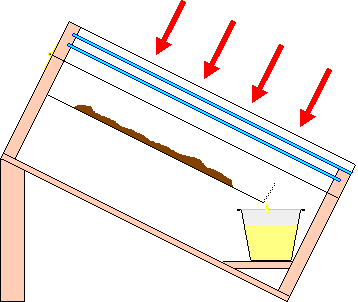| |
Solar Powered Wax Extractor
Solar wax extraction is popular with beekeepers as the energy source is free.
Beekeepers are known for a prudence and frugality that borders on the miserly Nothing wrong in that if it doesn't damage the planet> R.P.).
|
|---|
The solar powered wax extractor is a device for melting beeswax from old comb or
part rendered blocks, that is powered by the sun, has no moving parts and can be left
unattended.
There are many plans regularly published in beekeeping
magazines, online etc. Before you make one, consider how you will use it, as that will influence your design.
My personal one is rather small as I was working around an existing
metal reflector, but if I were making one now I would make it large
enough to accept a stack of ten framed queen excluders. (If you don't wish to make one, they are readily available from equipment suppliers, but make sure it is sturdy and will stand being outside in all weather. I have
seen some poorly made ones on sale. R.P.).
 All it amounts to is a simple box with a hinged lid that
is double glazed (This is helpful, but can be single glazed. R.P.). There is a collector for the melted wax and a metal
tray that has an "8" mesh filter at the bottom end. The
whole device is arranged so that the face of the double glazing is
perpendicular to the angle of maximum insolation.
All it amounts to is a simple box with a hinged lid that
is double glazed (This is helpful, but can be single glazed. R.P.). There is a collector for the melted wax and a metal
tray that has an "8" mesh filter at the bottom end. The
whole device is arranged so that the face of the double glazing is
perpendicular to the angle of maximum insolation.
The device that I have in my back garden is similar to the
diagram, but the box is insulated by expanded polystyrene sheets on
the outside and then the outside of the insulation is further covered
by a skin of shiplap boards. Even with this extra insulation it only
runs well on days with clear blue sky and summer sun. It will deal
with a kilo of wax per day if the sun shines and it will cope
adequately with my current needs.
Greenhouse glass is recommended for the glazing and the
uppermost sheet overlaps the reduced top edge of the bottom part of
the frame to allow rainwater to run off without collecting or
penetrating into the box.
The mesh along the bottom edge of the melting tray is
intended to strain out any large particles of debris and stop them
reaching the collecting tray. I found that a certain amount of
particulate debris would still find it's way into the collector and
so I took some cotton twine and wove it in and out of the holes in the
mesh. The fluffy nature of the twine retains the debris, but allows
the liquid wax to flow unhindered. The large particles and cocoons
remain on the metal tray and after draining under the influence of
a hot sun for a day or so after the main melting the sludge is scraped
out and I discard it. It can be used for garden compost or as a fire
lighting medium. There is also a method (Slum Gum Press) by which the
remaining wax can be removed.
Ladies' tights (panty hose) can be utilised in Solar
extractors... The rough quality wax and old comb are stuffed into the
legs and then tied off. The sausages so formed are put in the
extractor and the fine mesh retains a good deal of the debris whilst
the molten wax runs easily out. (If old brood combs are put in a solar wax extractor, there is a lot of wax retained in the cocoons and general debris. I find that a hand held potato masher will remove much of it. R.P.)
Originally written by Dave Cushman. Edited and additions by Roger Patterson.
Page created 12/02/2002
Page updated 30/12/2022
Written... 12 February 2002,
Additions... 10 November 2002,
Upgraded... 13 June 2006,
|
 All it amounts to is a simple box with a hinged lid that
is double glazed (This is helpful, but can be single glazed. R.P.). There is a collector for the melted wax and a metal
tray that has an "8" mesh filter at the bottom end. The
whole device is arranged so that the face of the double glazing is
perpendicular to the angle of maximum insolation.
All it amounts to is a simple box with a hinged lid that
is double glazed (This is helpful, but can be single glazed. R.P.). There is a collector for the melted wax and a metal
tray that has an "8" mesh filter at the bottom end. The
whole device is arranged so that the face of the double glazing is
perpendicular to the angle of maximum insolation.